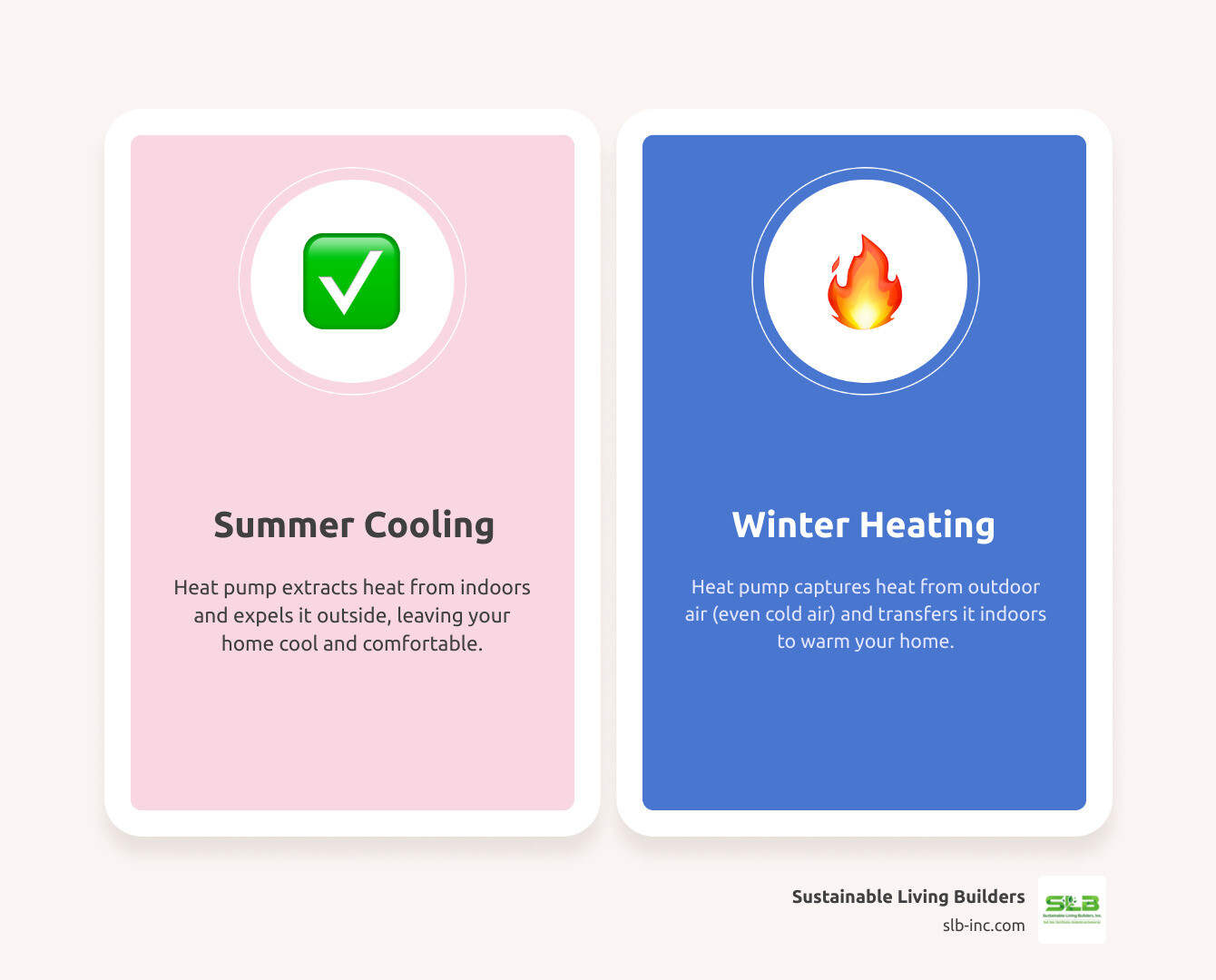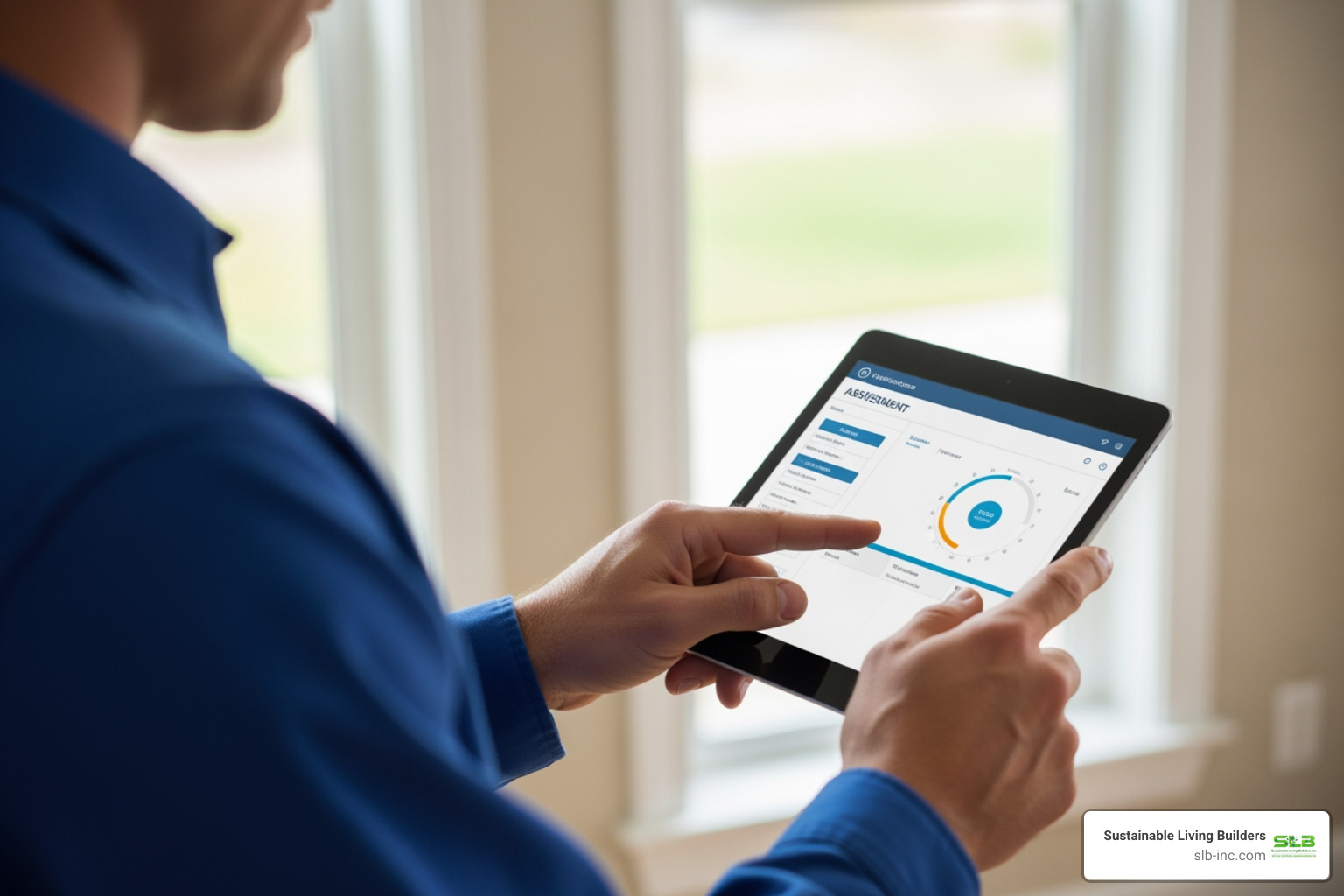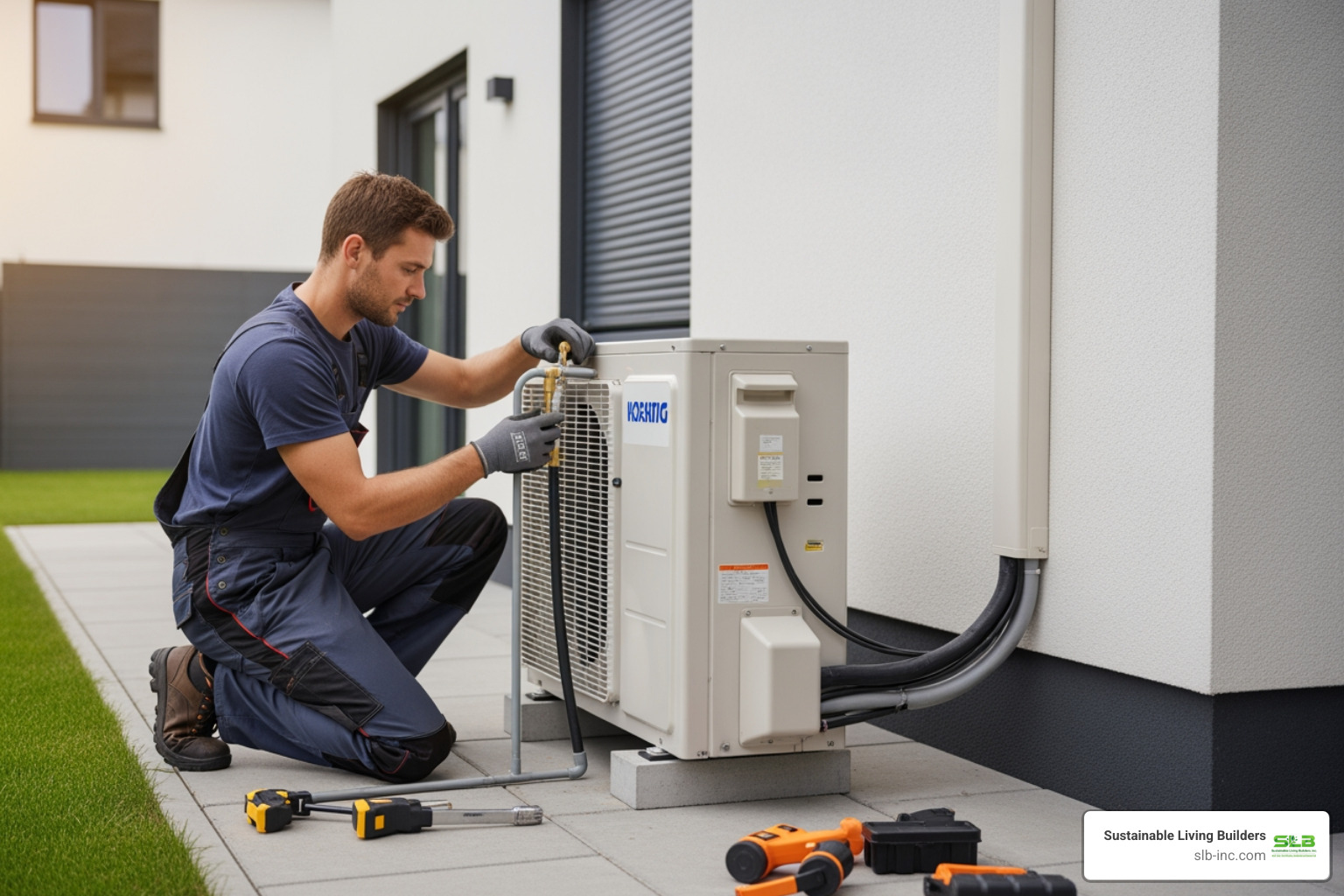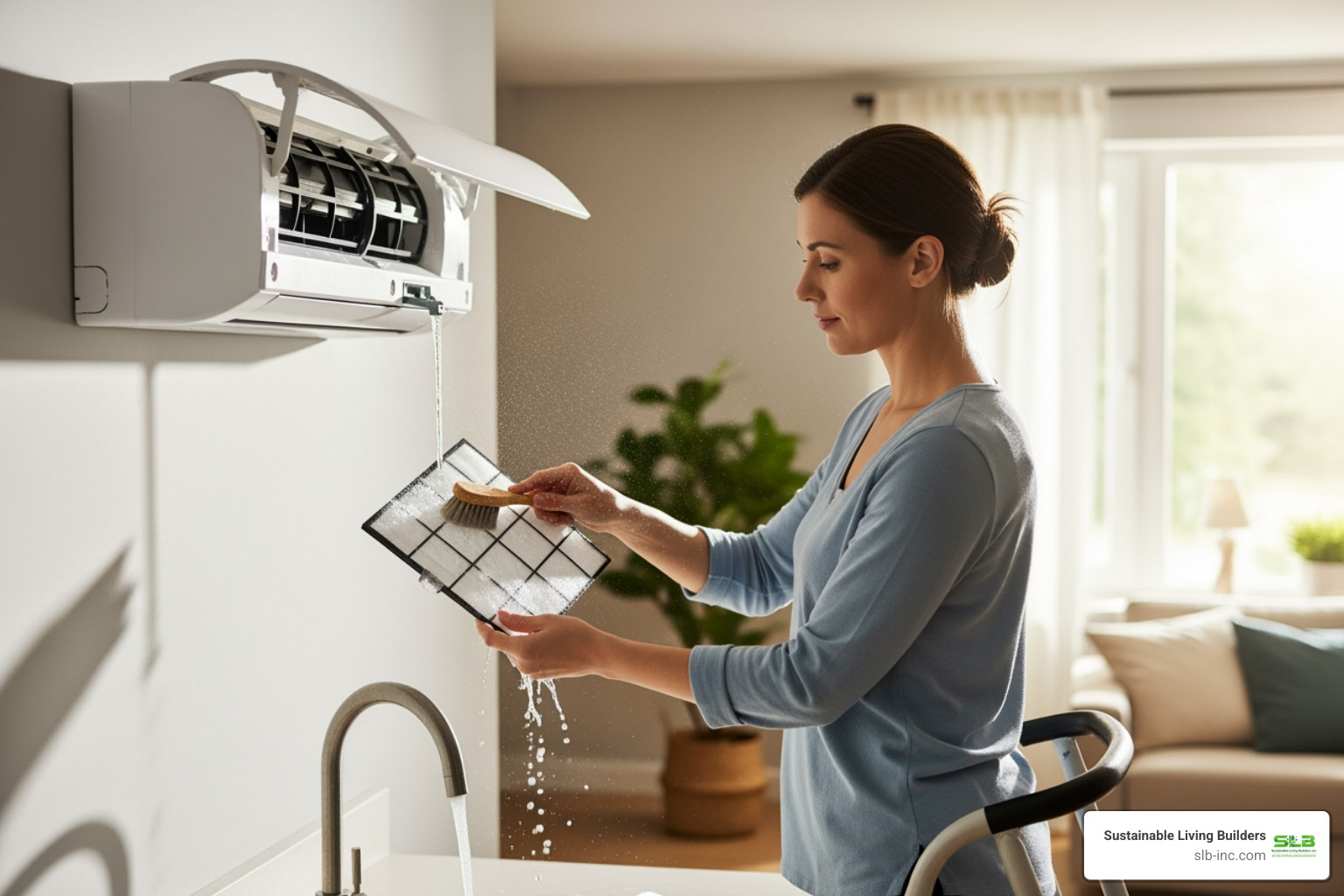Understanding Heat Pumps and Their Benefits
An AC heat pump installation is a key step toward reducing your energy bills and environmental impact. Unlike furnaces that burn fuel, a heat pump is an all-in-one heating and cooling system that works by transferring heat. In winter, it moves warmth from the outside air into your home; in summer, it reverses the process to cool your home. This efficient method of heat transfer can significantly cut your energy use and provide year-round comfort.
The installation process involves a home assessment, proper system sizing, site preparation, installation of indoor and outdoor units, and thorough system testing to ensure peak efficiency. If you’re considering a broader home electrification strategy, explore our Step-by-Step Guide to Transitioning from Gas to Electric Heating Systems. Ready to get started? Learn more about our Home Electrification services.

What are the Different Types of Heat Pumps?
When considering an AC heat pump installation for your home in Santa Rosa, Sonoma County, Marin County, or Napa County, it’s helpful to understand the different types available.
- Air-Source Heat Pumps: The most common type, these transfer heat between your home and the outside air. Modern units are highly efficient and operate effectively even in cooler climates.
- Ground-Source (Geothermal) Heat Pumps: These systems use stable underground temperatures to exchange heat via buried loops. While the installation is more complex, they offer superior long-term energy savings and low operating costs.
- Ductless Mini-Split Heat Pumps: Ideal for homes without ductwork or for zoned heating and cooling. An outdoor unit connects to one or more indoor units, each controlling a specific zone for customized comfort and high efficiency.
- Central vs. Zoned Systems: Central systems use ductwork to heat and cool an entire house. Zoned systems, often using mini-splits, allow for independent temperature control in different areas, saving energy by only conditioning occupied spaces.
Key Benefits for Your Home
Investing in an AC heat pump installation offers a wealth of benefits for homeowners in our region.
- Year-Round Comfort: A single system provides both heating and cooling with consistent temperatures.
- Improved Indoor Air Quality: Advanced filtration helps remove pollutants, allergens, and dust.
- Excellent Dehumidification: Heat pumps effectively remove excess humidity during cooling cycles, improving comfort and preventing mold.
- Quiet Operation: Modern heat pumps, especially mini-splits, are designed for quiet operation.
- High Energy Efficiency: By transferring heat instead of creating it, heat pumps use far less energy, leading to lower utility bills.
- Reduced Carbon Footprint: Efficient, electric-powered operation significantly cuts your home’s greenhouse gas emissions.
- Increased Home Value: A modern, energy-efficient heat pump is an attractive feature for potential buyers.
Preparing for Your Heat Pump Installation

Before your AC heat pump installation begins, proper preparation is key to ensuring your new system performs efficiently for decades. Our team starts with a comprehensive home efficiency evaluation, examining your home’s insulation, windows, and air sealing.
The most critical step is proper system sizing. An undersized unit will struggle on extreme days, while an oversized one will waste energy and wear out prematurely. We perform a Manual J load calculation for every installation, a detailed assessment that considers your home’s orientation, windows, insulation, ceiling heights, occupancy, and local climate patterns in Santa Rosa, Sonoma, Marin, and Napa Counties. This ensures your heat pump is perfectly matched to your home’s specific needs.
We also help you explore available government incentives and rebates, which can significantly reduce your upfront investment.
The Importance of Home Efficiency
Your heat pump’s performance depends heavily on your home’s overall efficiency. Without proper insulation and air sealing, conditioned air escapes, forcing your system to work harder. We often recommend addressing these areas before or during your AC heat pump installation.
- Insulation: Proper insulation in your attic, walls, and crawl spaces acts as a thermal barrier, keeping heat where you want it. Our Insulation Installation in Santa Rosa, CA services can transform your home’s energy retention.
- Air Sealing: Sealing air leaks around windows, doors, and outlets prevents your expensive heated or cooled air from escaping.
- Windows: Upgrading from older, single-pane windows to energy-efficient models can dramatically improve comfort and reduce the load on your heat pump.
- Ductwork Inspection: For central systems, leaky or poorly insulated ducts can waste 20-30% of the energy your system produces. We inspect, seal, and upgrade ductwork to ensure conditioned air reaches its destination efficiently.
These improvements create the ideal environment for your heat pump to operate at peak performance. We believe in the Importance of Sustainable Insulation as the foundation of an efficient home.
Electrical, Permitting, and Siting Considerations
A smooth AC heat pump installation requires careful planning.
- Electrical Panel Capacity: We assess your electrical panel to ensure it can support the dedicated 120V or 240V circuit your heat pump requires. We’ll determine if an upgrade is needed and install a disconnect box near the outdoor unit for safety and maintenance.
- Permits and Codes: We handle all permit acquisition and ensure your installation meets all local building codes in Santa Rosa, Sonoma County, Marin County, and Napa County, protecting your investment.
- Outdoor Unit Placement: The unit should be placed in a shaded area if possible, on a level pad with adequate clearance for airflow and maintenance (typically at least four inches behind and twenty inches in front/above). We work with you to find a location that is both functional and unobtrusive.
- Indoor Unit Location: For central systems, the indoor unit is placed in a furnace closet or utility space. For ductless mini-splits, indoor units are mounted on interior walls in central locations within each zone, away from direct heat sources and with proper clearance for optimal airflow.
The AC Heat Pump Installation Process Explained

The actual AC heat pump installation is a carefully orchestrated series of steps requiring expertise and precision. A shocking 90% of HVAC systems are installed incorrectly, leading to wasted energy and poor performance. Our commitment is to get it right the first time.
On installation day, our team prepares your home by laying down protective coverings. If we’re replacing an old system, we begin by safely recovering all refrigerant according to EPA standards, as venting it is illegal and environmentally harmful.
Key Steps for a Central Air-Source AC Heat Pump Installation
For a central system, your AC heat pump installation unfolds through several key steps:
- Outdoor Unit Placement: We position the outdoor condenser on a stable, level composite pad. This prevents vibration and protects the unit from ground moisture, ensuring proper drainage and airflow with adequate clearance on all sides.
- Indoor Coil Installation: We install the indoor evaporator coil, which connects to the refrigerant lines. We recommend cased coils, which are better protected and help prevent condensation issues.
- Refrigerant Line Connection: Our technicians use brazing—a high-temperature welding technique—to create leak-free connections for the copper refrigerant lines. We flow nitrogen through the lines during this process to prevent internal oxidation, which can harm the system.
- Condensate Drain Setup: We install a condensate drain line with a continuous downward slope to carry away water produced during the cooling cycle. If needed, a condensate pump is installed.
- Electrical Connections: We complete all high-voltage and low-voltage wiring according to code, including the required safety disconnect box near the outdoor unit.
Understanding Geothermal and Mini-Split Installations
Alternative AC heat pump installation approaches are available for different homes.
- Geothermal Installations: Instead of exchanging heat with the air, these systems use ground loops buried in your yard (horizontally in trenches or vertically in boreholes). These loops circulate fluid to exchange heat with the stable temperatures of the earth, offering exceptional efficiency.
- Ductless Mini-Split Installations: Perfect for homes without ductwork, these systems feature one or more indoor air handlers mounted on interior walls. We drill a small, sealed hole (about 3 inches) through an exterior wall to connect the indoor unit to the outdoor unit via a line set. For multi-zone systems, a single outdoor unit can connect to multiple indoor units for independent room-by-room temperature control.
Finalizing the Installation: Commissioning and Testing
This final phase is critical for ensuring efficiency and is often rushed by other installers. We take our time to guarantee performance.
First, we perform a deep vacuum pull on the refrigerant circuit to remove all moisture and contaminants, using a micron gauge to verify a stable vacuum below 100 microns. This confirms the system is leak-free.
Next, we charge the system with refrigerant, measured precisely by weight according to manufacturer specifications. For ducted systems, we balance the airflow to each room and calibrate the thermostat to work seamlessly with your new heat pump.
Finally, we run a comprehensive system function test, cycling through all modes (heating, cooling, defrost) to verify proper operation. This commissioning process, which can take up to two hours, is the difference between a system that simply works and one that works brilliantly for years.
After the Installation: Maintenance and Professional Care

Once your AC heat pump installation is complete, we conduct a thorough walkthrough to ensure you’re comfortable with your new system. We’ll show you how to use the thermostat, explain normal operational sounds, and provide all warranty information. A well-maintained heat pump can last 15 to 20 years, and we’re here to partner with you for the long haul.
DIY vs. Professional Installation: Why Expertise Matters
While a DIY AC heat pump installation might seem tempting, up to 90% of all HVAC systems are installed incorrectly, leading to high energy bills, frequent repairs, and a shortened lifespan. Professional installation is crucial for several reasons:
- Safety: Handling refrigerant requires EPA certification, and incorrect high-voltage electrical work poses a serious fire and electrocution risk.
- Performance: Professionals perform accurate Manual J load calculations, ensure leak-free connections, and properly charge the system to guarantee the efficiency and comfort you’re paying for.
- Longevity: A correct installation protects your investment and ensures your system reaches its full operational lifespan.
Essential Post-Installation AC Heat Pump Installation Maintenance
Regular care is key to your heat pump’s reliability. We’ll show you how to perform these simple but important tasks.
- Clean Air Filters: Check filters monthly and clean or replace them as needed. A dirty filter restricts airflow, wastes energy, and can damage the system. For mini-splits, filters slide out easily for rinsing.
- Keep the Outdoor Unit Clear: Regularly remove leaves, grass, and debris from around the outdoor unit. Ensure plants or other objects aren’t blocking airflow.
- Schedule Annual Professional Maintenance: A yearly service check is vital. Our technicians inspect refrigerant levels, clean coils, check electrical connections, lubricate parts, and test all functions. This preventative care catches small issues before they become costly repairs and maximizes your system’s efficiency and lifespan.
Common Troubleshooting for New Heat Pump Owners
Most unusual behavior has a simple explanation. Here are a few common scenarios:
- Uneven Heating/Cooling: First, check for a clogged air filter or blocked vents. If the problem persists, it may require professional airflow balancing.
- Frequent Cycling: If the unit turns on and off rapidly, check for debris blocking the outdoor coil. If it’s clear, it could indicate a thermostat or sizing issue that needs a professional diagnosis.
- Strange Noises: Grinding, squealing, or rattling noises are not normal and indicate a problem. Turn the system off and call for service to prevent further damage.
- Ice on Outdoor Unit: Some frost in winter is normal, and the unit will run a defrost cycle to melt it. However, thick ice buildup or ice that persists for hours signals a problem that requires immediate attention.
- Thermostat Issues: First, try replacing the batteries. Ensure the thermostat is set to the correct mode (heat/cool) and isn’t affected by drafts or direct heat sources.
Frequently Asked Questions about Heat Pump Installation
How long does a typical heat pump installation take?
A standard AC heat pump installation typically takes between four and eight hours. The exact time depends on the complexity of the job. A simple replacement of an existing outdoor unit may take half a day, while more involved projects like installing a geothermal system, modifying ductwork, or setting up a multi-zone mini-split system can take longer.
Can a heat pump be added to my existing HVAC system?
Yes, in many cases. If your home has existing ductwork, a heat pump can often replace your current outdoor air conditioner and work with your indoor furnace. This creates a “hybrid” or “dual fuel” system where the heat pump handles most heating and cooling, and the furnace provides supplemental heat on the coldest days. For homes without ducts, ductless mini-splits are an excellent solution. A professional assessment is necessary to determine compatibility and the best approach for your home.
How can I tell if my heat pump was installed incorrectly?
Since a high percentage of HVAC systems are installed improperly, it’s wise to know the warning signs. If you experience any of the following, your AC heat pump installation may have been done incorrectly:
- High Energy Bills: Your utility costs are not decreasing as expected.
- Uneven Temperatures: Some rooms are too hot while others are too cold.
- Frequent Cycling: The system turns on and off in short, frequent bursts.
- Strange Noises: You hear persistent grinding, squealing, or rattling.
- Poor Airflow: Weak airflow from your vents.
- Excessive Ice: Thick ice builds up on the outdoor unit in mild weather.
If you notice these issues, a professional inspection can diagnose the problem and ensure your system operates as it should.
Conclusion: Accept a More Sustainable Home
Choosing an AC heat pump installation transforms your home into a more comfortable, efficient, and environmentally responsible space. By transferring heat rather than generating it, you gain year-round comfort, lower energy bills, cleaner indoor air, and a significantly reduced carbon footprint. For homeowners in Santa Rosa, Sonoma County, Marin County, and Napa County, it’s a choice that aligns with our region’s commitment to sustainability.
At Sustainable Living Builders, our holistic approach ensures your heat pump is part of a complete energy-saving system, including proper insulation and air sealing. We are here to guide you toward a home that delivers maximum comfort and efficiency.
Ready to learn more? Dive into The Guide to Sustainable Building Practices: Strategies & Trends. When you’re ready to take the next step, explore our complete Home Electrification solutions.
